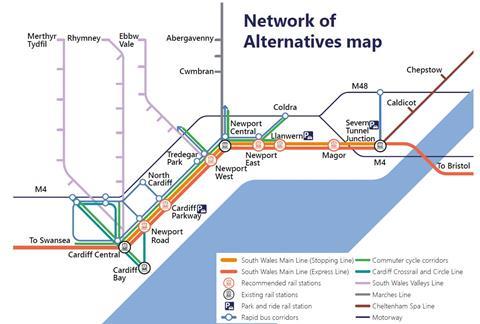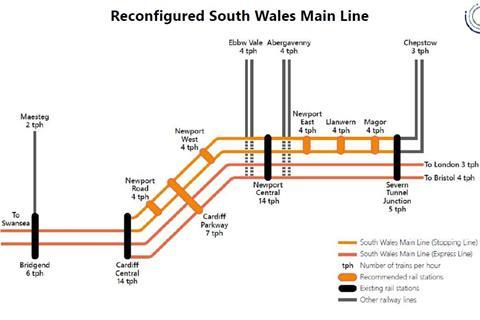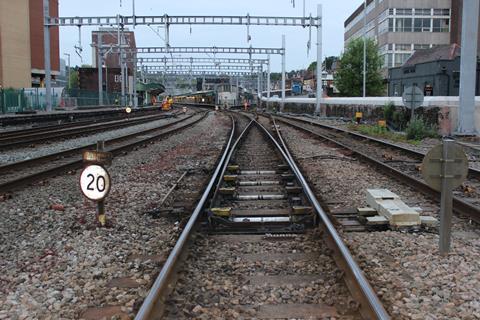
UK: Investment in a ‘comprehensive and co-ordinated’ programme of railway enhancements, rapid bus routes and active travel instead of road construction has been recommended by the South East Wales Transport Commission.
The Commission chaired by Lord Burns was established by the Welsh government’s Minister for Economy, Transport & North Wales Ken Skates in October 2019, and was tasked with recommending ways to reduce congestion on the M4 motorway without building the Newport relief road which the First Minister had announced would not go ahead.
On November 26 the Commission published its proposals for a public transport ‘network of alternatives’ which would provide people with options that do not rely on the motorway, or even a car.
Rail enhancements
The ‘backbone’ of this network would be the rail corridor between Cardiff, Newport and the Severn Tunnel, which was recently electrified at 25 kV 50 Hz and has modern signalling and spare capacity.

Investment would focus on making better use of the corridor, with the Commission believing it would be possible to almost double capacity without requiring major construction works or impacting existing long-distance services.
Six new stations would be built at Newport Road (Cardiff), Cardiff Parkway (St Mellons), Newport West, Newport East (Somerton), Llanwern and Magor.

Stopping trains would be separated from inter-city traffic, with local services using the relief (slow) lines where the line speed would be raised from 95 km/h to 145 km/h.
Stopping trains would run through from destinations outside the immediate region, rather than simply operating as a local shuttles, to maximise journey opportunities and avoid the need to provide terminating and reversing facilities.
Wider proposals
The rail backbone for medium-distance travel within the region would be supported by ‘rapid bus’ and cycle corridors, especially within Newport. More than 90% of Cardiff and Newport’s population would live within 1·6 km of a station or rapid bus corridor.
In addition to infrastructure works, the report recommends:
- reorganising transport services, speeding up interchange, co-ordinating timetables and integrating ticketing;
- a new governance model with a ‘single guiding mind’;
- measures to reduce the need to travel, including ‘superfast’ broadband-enabled remote working sites so people can work closer to home;
- considering a workplace parking levy to influence travel choices once public transport improvements have been made;
- ensuring developments are built around the public transport network rather than the motorway.
At present many people ‘have little choice but to use the motorway, given the lack of public transport options’, said Lord Burns. ‘We believe that a competitively priced, efficient and reliable public transport network could become the first choice for many travellers.
‘Even a moderate reduction in the number of cars travelling on the M4 could result in a significant improvement to the travel flow. The changes we are suggesting would generate considerable extra capacity in our region’s transport system. This shift to public and active transport would have many wider benefits beyond relieving congestion, including cutting air pollution, improving public health, and providing better access to jobs and services for everyone.’
Timescales

The change in commuting patterns resulting from the coronavirus pandemic has spread out travel peaks, and the Commission believes this will help to buy time to undertake the proposed works before capacity becomes critical.
Lord Burns told Rail Business UK that the implementation of the rail elements of the project could take five to 10 years, although the bus and active travel elements could be completed much more quickly, within five years. ‘Doing anything with railways does take time’, he said. ‘The important thing is to get started as quickly as possible.’
| Southeast Wales transport enhancents estimated capital costs | |
|---|---|
|
Element |
Indicative cost range £m |
|
Rail backbone upgrading and reconfiguration |
130-180 |
|
Rail backbone consequential improvements |
140-190 |
|
New stations |
120-170 |
|
Rapid bus routes |
100-130 |
|
Commuter cycle corridors |
40-90 |
|
Other measures |
60-80 |
|
Total |
590-840 |
|
Ongoing annual costs |
15-35 |



